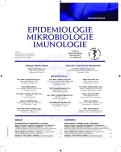Phylogenetic and molecular analysis of A/H1N1pdm influenza viruses isolated in the epidemic season 2012/2013 from hospitalised patients with symptoms of influenza-like illness
Authors:
A. Nagy 1,5; H. Jiřincová 1; M. Havlíčková 1; O. Džupová 2,3; K. Herrmannová 2,4; M. Trojánek 2,4; J. Kynčl 1,3
; Z. Blechová 2,4; V. Marešová 2,4
Authors‘ workplace:
Centrum epidemiologie a mikrobiologie, Státní zdravotní ústav, Praha
1; Klinika infekčních nemocí, Nemocnice Na Bulovce, Praha
2; 3. lékařská fakulta, Univerzita Karlova v Praze
3; 2. lékařská fakulta, Univerzita Karlova v Praze
4; Státní veterinární ústav, Praha
5
Published in:
Epidemiol. Mikrobiol. Imunol. 63, 2014, č. 2, s. 83-87
Category:
Review articles, original papers, case report
Overview
Aim:
To perform phylogenetic and molecular analysis of A/H1N1pdm influenza viruses isolated in the epidemic season 2012/2013 from hospitalised patients with symptoms of influenza-like illness (ILI).
Material and methods:
The study set included 34 strains of the A/H1N1pdm influenza virus isolated in the Czech Republic in the epidemic season 2012/2013. The strains were analysed by partial or whole-genome sequencing. The genome segments were compared at the nucleotide and amino acid levels, absolute and percentage sequence identity were determined, and phylogenetic relations were identified. The last steps were the comparison of the H1 molecule with that of the most recent vaccine strain and identification of the genotypic structure and molecular markers linked to the pathogenicity and antiviral resistance.
Results:
Phylogenetic analysis of the H1 molecule suggested that all 34 A/H1N1pdm isolates from the 2012/2013 season in the Czech Republic should be assigned to H1 group 6 divided into sublineages 6A and 6B. The comparison of the known antigenic regions of the H1 molecule with those in the most recent vaccine strain revealed two stable changes in antigenic regions Sb and Ca1. Furthermore, sporadic mutations were identified in antigenic regions Ca2, Cb, and Sb. Genotyping revealed co-circulation of two related but clearly distiguishable genotypes of A/H1N1pdm. All isolates showed sensitivity to oseltamivir. One strain consisted of two N1 sub-populations, one oseltamivir sensitive and the other oseltamivir resistant, in nearly equimolar proportions.
Conclusion:
All A/H1N1pdm isolates from the epidemic season 2012/2013 in the Czech Republic formed a phenotypically uniform group. At the nucleotide level, the divergence was relatively more pronounced and H1 sublineages and discrete genotypes were possible to identify. H1 molecules were highly identical to those of the vaccine strain A/California/7/2009 (H1N1) which showed that the current vaccine was protective enough. All strains were sensitive to oseltamivir; however, the selection of oseltamivir resistant N1 subpopulations was observed.
Keywords:
influenza – H1N1 – phylogenetic analysis – genotype – resistance
Sources
1. Kyncl J, Havlickova M, Nagy A, Jirincova H, Piskova I. Early and unexpectedly severe start of influenza epidemic in the Czech Republic during influenza season 2012–13. Euro Surveill, 2013;18(6):pii 20396.
2. Manual for the laboratory diagnosis and virological surveillance of influenza[online]. Geneva: World Health Organization, 2011[cit. 2012-12-18]. ISBN: 9789241548090. Dostupné na www: http://whqlibdoc.who.int/publications/2011/9789241548090_eng.pdf
3. Hall TA. BioEdit: a user-friendly biological sequence alignment editor and analysis program for Windows 95/98/NT. Nucleic Acids Symp Ser, 1999;41:95–98.
4. Katoh K, Misawa K, Kuma K, Miyata T. MAFFT: a novel method for rapid multiple sequence alignment based on fast Fourier transform. Nucleic Acids Res; 2002;30(14):3059–3066.
5. Felsenstein J. PHYLIP (Phylogeny Inference Package) Version 3.6. Distributed by the Author. Department of Genome Sciences[online]. Seattle: University of Washington, 2004[cit. 2012-12-18]. Dostupné na www: http://evolution.genetics.washington.edu/phylip.html.
6. Tamura K, Dudley J, Nei M, Kumar S. MEGA4: Molecular Evolutionary Genetics Analysis (MEGA) software version 4.0. Mol Biol Evol, 2007;24(8):1596–1599.
7. EPIFLU™ database[online]. GISAID. The Global Initiative on Sharing All Influenza Data, 2011[cit. 2014-12-18]. Dostupné na www: http://platform.gisaid.org/epi3/frontend#4efb5b.
8. Influenza virus characterisation. Summary Europe, February 2012. Technical document[online]. Stockholm: ECDC, 2012[cit. 2012-12-18]. Dostupné na www: http://www.ecdc.europa.eu/en/publications/publications/1203_ted_cnrl_report_feb2011.pdf
9. Deyde VM, Sheu TG, Trujillo AA, Okomo-Adhiambo M, Garten R, Klimov AI, Gubareva LV. Detection of molecular markers of drug resistance in 2009 pandemic influenza A(H1N1) viruses by pyrosequencing. Antimicrob Agents Chemother, 2010;54(3):1102–1110.
10. Howard WA, Essen SC, Strugnell BW, Russell C, Barrass L, Reid SM, Brown IH. Reassortant pandemic (H1N1) 2009 virus in pigs, United Kingdom. Emerg Infect Dis, 2011;17(6):1049–1052.
Labels
Hygiene and epidemiology Medical virology Clinical microbiologyArticle was published in
Epidemiology, Microbiology, Immunology

2014 Issue 2
Most read in this issue
- A point prevalence survey of healthcare-associated infections in the Slovak Republic – a part of the EU project
- Candida dubliniensis in clinical specimens and possibilities for identification
- Q fever – an occupational disease leading to disability – case report
- Diagnosis of Clostridium difficile infections: Comparative study of two immuno enzyme assays with confirmation by PCR and culture followed by PCR ribotyping
